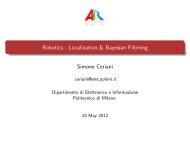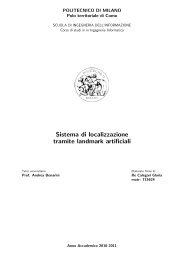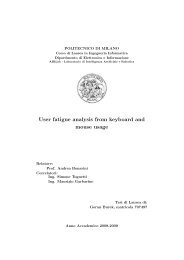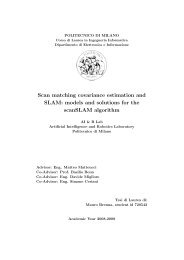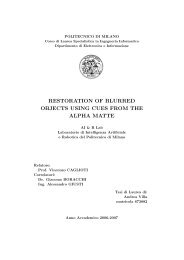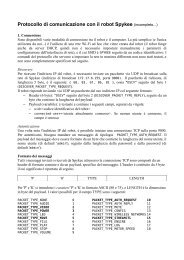Submitted version of the thesis - Airlab, the Artificial Intelligence ...
Submitted version of the thesis - Airlab, the Artificial Intelligence ...
Submitted version of the thesis - Airlab, the Artificial Intelligence ...
You also want an ePaper? Increase the reach of your titles
YUMPU automatically turns print PDFs into web optimized ePapers that Google loves.
If <strong>the</strong> camera is set to SERVO MID, <strong>the</strong> position <strong>of</strong> <strong>the</strong> target is calculated<br />
with ’CalculatePositionGround’ function. The motor contributions<br />
are calculated using ’Triskar’ function, and <strong>the</strong> motor speeds from ’Triskar’<br />
are set with multiplier CLOSE. If <strong>the</strong> distance <strong>of</strong> <strong>the</strong> robot to target is less<br />
than 300 mm, <strong>the</strong> target is marked as acquired by setting ’color done =<br />
TRUE’.<br />
The detection <strong>of</strong> target acquired and game-over is done by controlling<br />
’color done’ on every loop. When <strong>the</strong> ’color done’ is set as ’TRUE’, <strong>the</strong><br />
camera head position is set to SERVO TOP, ’color done’ and ’blob found’<br />
are flagged as ’FALSE’, and color is incremented by 1. Since <strong>the</strong> current<br />
configuration is working with 2 colors, <strong>the</strong> case where ’color > 2’ is controlled<br />
for <strong>the</strong> game-over case. For that case, we introduced a variable as<br />
’reply counter’, which sets <strong>the</strong> number <strong>of</strong> replies/rounds to end <strong>the</strong> game.<br />
In <strong>the</strong> code, this variable is set as 5, that made <strong>the</strong> game to find and go to<br />
<strong>the</strong> targets 5 times, in <strong>the</strong> same color order defined. The work flow in <strong>the</strong><br />
main loop is shown in Appendix A.2.<br />
The class diagram that is showing <strong>the</strong> relation between <strong>the</strong> modules<br />
is reported in Appendix A A.1. We increased <strong>the</strong> modularity <strong>of</strong> <strong>the</strong> program<br />
by separating <strong>the</strong> code to improve reuse; breaking a large system into<br />
modules, makes <strong>the</strong> system easier to understand. By understanding <strong>the</strong> behaviors<br />
contained within a module, and <strong>the</strong> dependencies that exist between<br />
modules, it’s easier to identify and assess <strong>the</strong> ramification <strong>of</strong> change. We<br />
used <strong>the</strong> naming convention Init for initialization classes, functions. The<br />
algorithm are implemented inside <strong>the</strong> Motion and Vision classes. The motion<br />
algorithm is implemented by porting <strong>the</strong> s<strong>of</strong>tware simulator previously<br />
written to <strong>the</strong> microcontroller. The vision algorithms are also implemented<br />
in a similar manner. The camera calibration calculating <strong>the</strong> position <strong>of</strong> <strong>the</strong><br />
object was previously implemented in a Matlab script. Later, <strong>the</strong> script has<br />
been ported to <strong>the</strong> microcontroller.<br />
The rest <strong>of</strong> <strong>the</strong> implementation not mentioned above, focuses on pin<br />
assignments (in Appendix D.3), definitions <strong>of</strong> <strong>the</strong> constants, creation <strong>of</strong> <strong>the</strong><br />
header files.<br />
71




